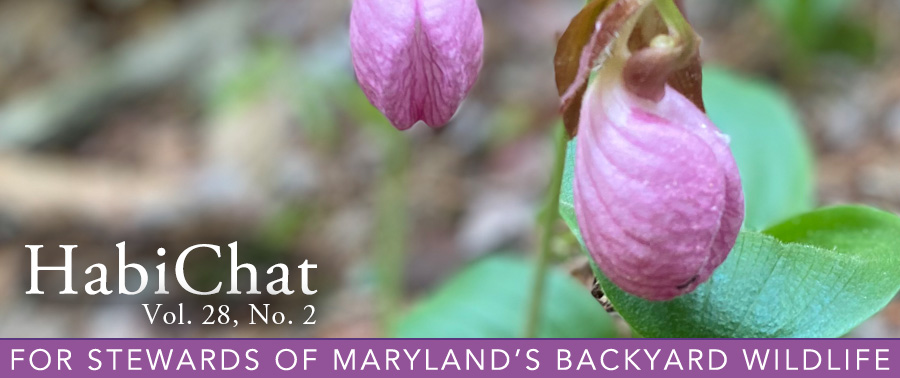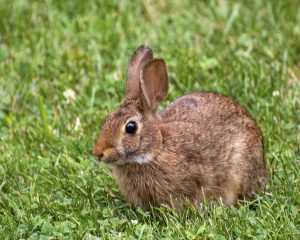By Sarah Witcher
Across the state, spring and summer bring about sightings of one of the most commonly spotted mammals in Maryland — rabbits! These shy, crepuscular creatures from the order Lagomorpha (in other words, they’re not rodents) prefer fields and shrublands but are commonly found in backyards and near homes, even in very urban areas. They are most often observed cautiously foraging in the dusk and dawn hours, using their highly adept senses to stay wary of the many threats to an animal preferred by hungry carnivores. Maryland was historically home to the snowshoe hare (the last recorded sighting was in 1952), but now only supports two species of rabbit: the eastern cottontail and today’s subject, the Appalachian cottontail.
Appalachian cottontails and eastern cottontails are very difficult to tell apart from physical appearance. Appalachians can have a black spot between their shorter ears while easterns can have a white spot on their heads, but neither of these traits is true for every individual (they didn’t read the field guide!) Comparisons of their skull structure and genetics prove that they are, in fact, different species, as well as their very different preferred habitats. Unless you live in the mountains of Western Maryland, it’s highly unlikely that you’ve ever seen an Appalachian cottontail; they consistently occur in high elevations with cover provided by species like mountain laurels, rhododendrons, and blueberries. They are herbivorous and feed on low-growing vegetation and bark, living very short lifetimes of rarely more than a year but reproducing at a rapid rate (like all rabbits) to maintain their populations. Though little is documented of Appalachian cottontail mating behavior specifically, rabbits in this genus tend to be polygamous with males competing over females in complex and sometimes aggressive displays of agility. Females can have three or more litters per season of up to five babies each, making nests lined with soft fur in covered depressions in the ground.
Even with all the bunny babies, Appalachian cottontail populations are declining at a rate scientists don’t yet fully understand. A 2019 Frostburg State University study in cooperation with Maryland Natural Heritage Program scientists used DNA found in scat to help researchers understand how many populations exist in western Maryland. Loss of habitat is the primary threat, caused by human changes to their native habitats. A 2020 study also found that in areas where they both occur, Appalachians can reproduce with eastern cottontails, creating hybridization that can cause the rarer species numbers to decline overall. Yet another threat comes in the form of a wildlife disease that’s somewhat new on the scene — rabbit hemorrhagic disease, also known as RHDV2. This disease only affects rabbits, both domestic and wild, and it kills up to 80% of the animals infected. Though it started in the western regions of the United States, it is slowly spreading east; biologists are not only keeping watch and taking preventative measures, but also have a plan in place in case it begins to affect our native wild species.
Interested in supporting wild cottontails? If you live in the Appalachian cottontail’s native range, remember to encourage the shrubby “rabititat” plants they prefer, as well as some of their favorite trees like native spruces, firs, pines, and hemlocks. Rabbits in any habitat need good cover, so creating or allowing brush piles to exist can be a game changer in attracting them and keeping them safe from predators. If you love rabbits but don’t love how they munch on your garden plants, consider fencing (at least 18 inches high) or try interspersing or planting a perimeter of plants they dislike. These include alliums, anything fuzzy or prickly (like lamb’s ear), and a number of pungent smelling herbs. Finally, if you ever come across a sick, injured, or orphaned rabbit, be sure to do your homework and use the appropriate wildlife rehabilitator to help.

Visit Us Online!

Appalachian Cottontail in Garrett County. Photo by Bill Hubick. | 
Brown Bunny (Eastern Cottontail). Photo by Gwen Neff |
“If you chase two rabbits, you catch none.” ~Confucius
Across the state, spring and summer bring about sightings of one of the most commonly spotted mammals in Maryland — rabbits! These shy, crepuscular creatures from the order Lagomorpha (in other words, they’re not rodents) prefer fields and shrublands but are commonly found in backyards and near homes, even in very urban areas. They are most often observed cautiously foraging in the dusk and dawn hours, using their highly adept senses to stay wary of the many threats to an animal preferred by hungry carnivores. Maryland was historically home to the snowshoe hare (the last recorded sighting was in 1952), but now only supports two species of rabbit: the eastern cottontail and today’s subject, the Appalachian cottontail.
Appalachian cottontails and eastern cottontails are very difficult to tell apart from physical appearance. Appalachians can have a black spot between their shorter ears while easterns can have a white spot on their heads, but neither of these traits is true for every individual (they didn’t read the field guide!) Comparisons of their skull structure and genetics prove that they are, in fact, different species, as well as their very different preferred habitats. Unless you live in the mountains of Western Maryland, it’s highly unlikely that you’ve ever seen an Appalachian cottontail; they consistently occur in high elevations with cover provided by species like mountain laurels, rhododendrons, and blueberries. They are herbivorous and feed on low-growing vegetation and bark, living very short lifetimes of rarely more than a year but reproducing at a rapid rate (like all rabbits) to maintain their populations. Though little is documented of Appalachian cottontail mating behavior specifically, rabbits in this genus tend to be polygamous with males competing over females in complex and sometimes aggressive displays of agility. Females can have three or more litters per season of up to five babies each, making nests lined with soft fur in covered depressions in the ground.
Even with all the bunny babies, Appalachian cottontail populations are declining at a rate scientists don’t yet fully understand. A 2019 Frostburg State University study in cooperation with Maryland Natural Heritage Program scientists used DNA found in scat to help researchers understand how many populations exist in western Maryland. Loss of habitat is the primary threat, caused by human changes to their native habitats. A 2020 study also found that in areas where they both occur, Appalachians can reproduce with eastern cottontails, creating hybridization that can cause the rarer species numbers to decline overall. Yet another threat comes in the form of a wildlife disease that’s somewhat new on the scene — rabbit hemorrhagic disease, also known as RHDV2. This disease only affects rabbits, both domestic and wild, and it kills up to 80% of the animals infected. Though it started in the western regions of the United States, it is slowly spreading east; biologists are not only keeping watch and taking preventative measures, but also have a plan in place in case it begins to affect our native wild species.
Interested in supporting wild cottontails? If you live in the Appalachian cottontail’s native range, remember to encourage the shrubby “rabititat” plants they prefer, as well as some of their favorite trees like native spruces, firs, pines, and hemlocks. Rabbits in any habitat need good cover, so creating or allowing brush piles to exist can be a game changer in attracting them and keeping them safe from predators. If you love rabbits but don’t love how they munch on your garden plants, consider fencing (at least 18 inches high) or try interspersing or planting a perimeter of plants they dislike. These include alliums, anything fuzzy or prickly (like lamb’s ear), and a number of pungent smelling herbs. Finally, if you ever come across a sick, injured, or orphaned rabbit, be sure to do your homework and use the appropriate wildlife rehabilitator to help.

Visit Us Online!
